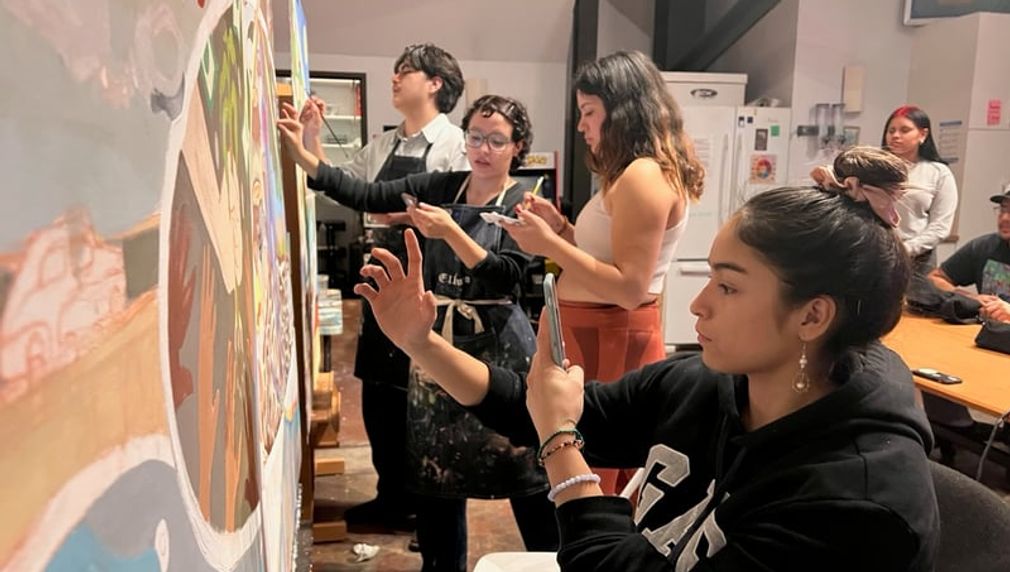Climate Mural & Fundamentals of Sustainability Workshops
This Climate Mural & Fundamentals of Sustainability Workshops program will bring sustainability education and community engagement to South Los Angeles by offering workshops and hands on learning kits to further sustainability engagement the disadvantaged neighborhood of Watts. Local program participants will help conceptualize, design, and install a smog-eating mural as an example of real world climate action to inspire survivors of violent crime and community students in the Sustainability Fundamentals Workshops.

What is the primary issue area that your application will impact?
Green Space, Park Access, and Trees
In which areas of Los Angeles will you be directly working?
South LA
In what stage of innovation is this project, program, or initiative?
Expand existing project, program, or initiative
What is your understanding of the issue that you are seeking to address?
Few communities within L.A. have experienced the level of historic and ongoing divestment experienced by this area of Watts. As a result, the area is nearly 5 degrees hotter than other areas of the city. Nearly 40 percent of area residents lack access to a vehicle, yet these tracts are skipped by the current Los Angeles County bike path development plan. While it is a Gang Reduction and Youth Development (GRYD) community, Watts has received none of the "Measure A" Park funds intended for these neighborhoods. This lack of safe, natural space to linger and rest shows in the area's pandemic impact. Green infrastructure is shown to create upward spirals of resilience. It has a particularly profound ability to help survivors of violence heal and set conditions for greater community harmony and health. Many students are already aware of environmental injustice and should be able to discuss this openly.
Describe the project, program, or initiative this grant will support to address the issue.
The Carbon Mural at the Survivors Healing Garden will have an intense impact on a small population. 20-30 Students and community volunteers involved with the planning, design and installation of the mural will feel connected to the theme and space created by this installation. Students and families who live around the garden will be able to visit the mural for decades to come inspiring future generations of green leaders and regenerative thinkers. Sustainability Fundamentals Workshops will have a broad impact on the larger South Los Angeles population because it will inspire youth, survivors, and their families to engage or begin sustainability efforts in their communities and show that there are many organizations collaborating every day on climate solutions. Students at the middle and high school level thinking about their future career goals will be inspired to join the green jobs movement towards a more sustainable future. These workshops help build the next generation of eco conscious community leaders and citizens thinking about regenerative solutions in their communities and the overall health paradigms they improve. This model combining education with a community project, whether art or garden installation, helps to instill confidence and trust in the communities. The hands-on elements apply real world issues to the big topics we discuss in the workshops with creativity and a visual, inspiring picture mural of what a more sustainable community of Watts can be.
Describe how Los Angeles County will be different if your work is successful.
USGBC-LA will work with the Mural Workforce Academy, local muralists, and the students to design and develop the mural that visualizes what sustainability can look like in their community, while teaching these artists how to use an environmentally friendly, particulate matter absorbing, mineral based paint. This collaboration with experts, local artists, students, and community members will help create a whole new generation of artists comfortable using more environmentally friendly materials and creating art with concepts around climate change and sustainability. In addition, USGBC-LA's Green Schools program is devoted to bringing the fundamentals of sustainability education to students and schools in our region at varying age levels through workshops that are taught by sustainability industry volunteers. Collaboration with volunteers from sustainability industries provides students and community members access to knowledge and networking often out of reach.
What evidence do you have that this project, program, or initiative is or will be successful, and how will you define and measure success?
Teachers and students in the program provide feedback throughout the process and adjustments are made to the program based on the needs of that class or group. Local program participants, artists, and students will help conceptualize, design, and install smog-eating mural to ensure the intended impact is sought out through a collaborative process. In addition, mural workshops at the Survivors Healing Garden will be open to all community members and anyone interested in the mural design, process and climate solutions involved. We aim the mural to reflect the culture and feeling of the community so future visitors to the Healing Garden will be inspired and feel seen in the climate action conversation. In addition to measurements and milestones, the openness of this project to the community and relationships with community partners are another key way we measure impact.
Approximately how many people will be impacted by this project, program, or initiative?
Direct Impact: 30
Indirect Impact: 5,000
Describe the role of collaborating organizations on this project.
USGBC-LA will work with the Mural Workforce Academy, local muralists, and the students to design and develop the mural that visualizes what sustainability can look like in their community, while teaching these artists how to use an environmentally friendly, particulate matter absorbing, mineral based paint. This collaboration with experts, local artists, students, and community members will help create a whole new generation of artists comfortable using more environmentally friendly materials and creating art with concepts around climate change and sustainability. In addition, Collaboration with volunteers from sustainability industries provides students and community members access to knowledge and networking often out of reach.